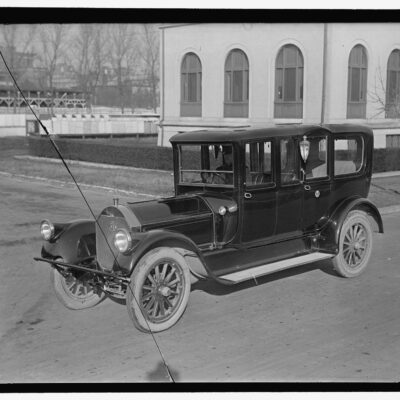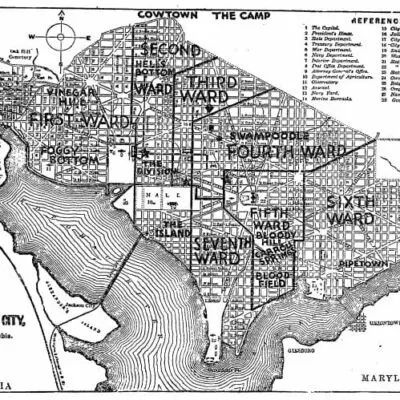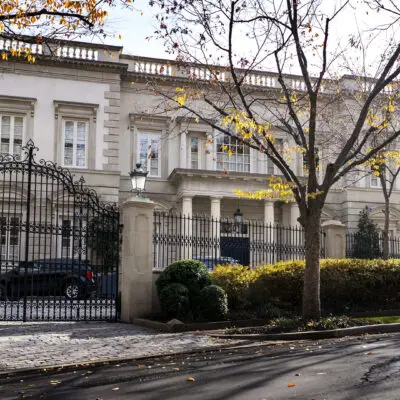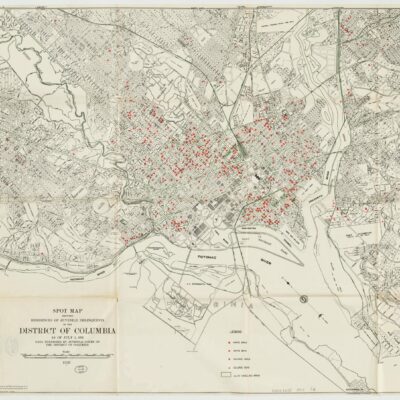Last week we posted a detailed topographical map of Rock Creek Park from 1866. There were some great comments on it, including GoDCer Elizabeth’s observation that the map was entitled “Location for a Public Park & Site for Presidential Mansion” … intriguing.

Another GoDCer, Carlton from Glover Park History, did some digging and came up with the Annual Reports of the Secretary of War, Volume 2 (thank you Google Books). It includes the report by Brevet Brigadier General N. Michler, who was in charge of public buildings in Washington and responsible for the map of Rock Creek.
It’s a very interesting (and really long) report that serious GoDCers will love digging into. I want to share some of it here for you, since we’re all intrigued by the White House potentially sitting in the middle of our beloved park. Also, as we know, Rock Creek Park was founded in 1890, a fair bit of time after this report.
Washington City January 29 1867
Sir: In compliance with the contents of your letters of the 24th and 26th of July 1866 addressed to the honorable Secretary of War, I was detailed by the Chief of Engineers with the consent of the General-in-chief to carry out the views of the committee in regard to the special duty assigned me. In the letters referred to you requested that an engineer officer be detailed to make the necessary preliminary surveys and maps of certain tracts of land adjoining or near this city for the purposes of a public park and also a suitable site for a presidential mansion, and which in the language of the Senate resolution of the 18th of the same month, “shall combine convenience of access and healthfulness good water and capability of adornment;” in addition to this to ascertain, if practicable the price of said lands.
After a careful examination of the many beautiful localities to be found in the vicinity of the capital, and having caused an accurate and detailed survey of its environs to be made, I now have the honor to submit for your consideration the conclusions to which I have arrived. In connection with this report two preliminary maps have been prepared which will show more plainly than words can express the required information and the respective advantages of the different sections. The Senate resolution would seem to imply that one and the same tract of land should be designated for a site for grounds for a presidential mansion as well as for a public park; but as it is not definitely so stated, it has been judged best by me to separate the subjects. Should such not be the intention of your honorable committee it will be easy to combine the two, where so many splendid situations present themselves from which to make a selection. As it is designed to build a home for the President to which he can retire from the active cares and business of his high office and where he can secure that ease comfort and seclusion so necessary to a statesman, it would seem best to locate it away from the constant turmoil of a city, life at such a distance where his privacy cannot easily be intruded upon, and still sufficiently accessible for fill practical purposes.
Washington was a swampy, sleepy, dirty and not very cosmopolitan at the time, not befitting the capital city of a great (or soon to be great) nation. In order to be that, we needed amenities similar to the great cities of the world. The report continues …
The dimensions of the most celebrated European parks are as follows:
London.–All parks in and near London, including gardens, squares, and parade grounds, 6,000 acres. Hyde Park, 380 acres; Regent’s Park, 372 acres; Windsor Little Park, 300 acres; Kensington 227 acres; Windsor Great Park, 3,500 acres; Richmond Park, 2,250 acres.
Dublin.–Phoenix Park, about 2,000 acres.
Garden at Versailles, 3,000 acres; Bois de Boulogne, 2,158 acres; Munich, Englischer Garten, about 500 acres; Vienna, Prater, 1,500 acres; Birkenhead Park, near Liverpool, 180 acres.
The Central Park of New York, the most important work of the kind undertaken in America, is over two and a half miles in length by one-half mile in breadth, and contains over eight hundred and forty acres. There are about nine and a half miles of drives, five and a half miles of bridle road, and some twenty-five miles of walks. The annual sum provided for the expense of maintaining it, to wit, $150,000, is reported to be insufficient. The number of visitors continue to increase with each year; in 1865, 7,593,139 persons entered. Hunting Course Park, near Philadelphia, and the Druid Park, near Baltimore, have also been constructed. The establishment of parks is exciting great attention throughout the land, and adds vastly to the enjoyment of the people.
To be a great city, you need a great park. To be a world-class city, you need to be at the scale of these great cities.
Also, say what you will about the New York versus D.C. comparison — New Yorkers complain about bars actually closing here or not being able to get Chinese take-out at 4 a.m. — Washington trumps New York with our park. I like Central Park, but our Rock Creek Park is far superior (and over three times the size).
Let’s keep going to the part about the new Presidential Mansion. This part gets pretty interesting and relates to an old post we wrote about the proposed mansion on Meridian Hill. The report details four potential sites.
I. Meridian Hill–(Colonel Messmore’s estate)–This site is located north from the present White House, on the first range of hills bounding limits of the city of Washington. It is of easy access, several avenues streets leading in that direction. On the east it adjoins the lands of Columbia College, and on the west those of Mr. Little. The number of acres contained this tract is one hundred and twenty, which added to that of Mr Little’s thirty eight acres gives a total of one hundred and fifty-eight. The latter offered to to the government at about six cents a square foot or $2,613 per acre. On these estates are eligible building sites; the view towards the south, the city and the valley of the Potomac, being particularly fine. At one some Large forest trees added beauty to the scene, but most of them were destroyed during the war. There are no improvements, the old mansion-house having been destroyed by fire, and the walls are alone standing. North of site the land is nearly level, only slightly undulating. Although possessed considerable advantages ,there are several objections to this selection, in connection with the object in view. Lying just above the plateau of the city, and not screened by any belt of timber, it is exposed to the miasmatic rising from the marshes of the Potomac. Again it is too near the city to any retirement and repose for the Chief Magistrate Already the street approach and numerous houses are being built on all sides of this site. Already the street railroads approach, and numerous houses are being built on all sides of this site.
Here’s the Google Map of the area for the Meridian Hill site.
II. Metropolis View–(Homestead of the late Washington Berry.)–This estate lies northeast of the Capitol, between the old Blandensburg road and Lincoln avenue, the latter a continuation of North Capitol street. It is distant from the Capitol about two and a half miles, and from the White House about three miles. It contains some three hundred and fifty acres, valued by the trustees at $500 an acres, with the improvements, including a very fine spring; the whole is offered at $200,000. To the east of it lies Brentwood, the fine estate of Mrs. Pearson, and to the west Glenwood Cemetery and Harewood, the beautiful grounds of Mr. Corcoran . In front spreads out Eckington, so many years the homestead of the late Mr. Gales, which contains 130 acres; the prices of this land is placed at $1,000 per acres, with $25,000 additional for improvements. Metropolis View is beautifully situated, having a high and commanding position; it is partially covered with groves of fine old trees, deciduous and evergreens, and possessed of an abundance of timber. A fine spring rises in the place, and two small streams, tributaries of the Tiber, course through it. In nearly every direction the eye meets with charming landscape scenes, and it overlooks the Capitol and the broad valley of the Potomac. This locality possesses many attractions, and is susceptible of the great improvement. It is easy of access by some of the finest avenues and streets leading out of the city, and is at a very convenient distance from the most prominent public buildings.
Eckington is a delightful place, but it is not sufficiently high to afford extensive views. It should, however, be purchased in addition to the Berry estate, should Metropolis View be selected as the site. The two tracts of land united would furnish ample grounds to surround the mansion, and also open a fine park to connect the city on the direct line with the Capitol. The sum total of the valuations of both estates amounts to $355,000. In regard to the healthfulness of this locality, the opinions of those with whom I have consulted differ very materially. Some think that the miasma carried up the valley of the Tiber from the Eastern branch is very deleterious to health, while others, who have long inhabited these homesteads, pronounce them to be perfectly salubrious.
Here’s the Google Map of the area for the Metropolis View site.
III. Harewood–(Mr. Corcoran’s estates.)–Among the many delightful drives around the city of Washington none can compare with those to be found within the enclosures of this delightful retreat. The grounds are most artistically arranged, and no expense has been spared in adorning them by all the appliances at the command of taste and wealth.
The grounds are naturally beautiful and undulating, and all that skill can accomplish has been applied to render them most charming and picturesque. In addition to the natural growth of vegetation, many trees and plants of other nations and climes have been introduced to impart their luxuriance to the scene. The estate covers some two hundred acres, but as you follow the gentle windings of the drives and walks, the imagination is led to believe it to be of much greater extent. Good roads lead to it from the city, making it perfectly accessible. A fine spring furnishes a plentiful supply of water, and in point of health it is all that can be desired. This spot, originally selected by the proprietor upon to erect a princely mansion, is one of the most delightful situations among the many fine ones in the environs of Washington; it would be a most eligible site for a presidential mansion.
Here’s the Google Map of the approximate area of Harewood.
IV. The homestead of Mr. Moncure Robinson.–This estate is now occupied by the brother of the proprietor, the latter residing in the city of Philadelphia. It lies adjoining the lands belonging to the United States Military Asylum; the road which leads out of the city on the prolongation of North Capitol street, and passes near the Home for the old soldiers, almost divided the place into equal parts. There are about seventy acres in all, which the owner proposes to sell at $1,000 per acre, without the improvements; these he values at $30,000. The mansion occupies one of the most elevated positions in the neighborhood of Washington. An extensive panorama of the surrounding country lies before the beholder; from every point of the compass the eye can dwell upon magnificent landscapes extending far into Maryland and Virginia, and combining all that is beautiful and picturesque. In one direction the gaze rests for miles on the waters of the majestic Potomac, and in another there are mountains and hills mantled with forests, and plains and valleys highly cultivated. The place contains a large portion of heavy timber, and is so situated as to offer numerous advantages for improvement. From its great height it will be far above all malarious influences. There are fine springs in the neighborhood, which furnish an abundance of water for useful and ornamental purposes. The locality is convenient to both cities. Through Washington several avenues and streets lead towards the road above referred to as connecting with North Capitol street; by this drive a straight-line communication can be had with the Capitol, the distance between the two being less than four miles. By the avenue and streets connecting with the Fourteenth street road and Seventh street turnpike, thence by Rock Creek Church road, a very direct drive of a little over four miles can be had with the White House and the public buildings adjoining it. From Georgetown almost an air-line can be had via Boundary street, Taylor’s lane, and Rock Creek Church road, distance of about four miles.
Directly in front, or south of Mr Robinson’s beautiful locality, lie the very pretty grounds of Mrs. R. S. Wood, consisting of forty acres. The two must be considered inseparable should the Robinson site be selected for a presidential mansion. They are valued at about $1,000 per acre, not including the improvements. The two places can probably be purchased for $150,000. Mrs. Wood’s tract joins Harewood on the south, and on the west that of the Military Asylum. The lands of the latter do not belong to the government, but are in trust for the old soldiers, and contain some two hundred and fifty-eight acres. A reference to the map will show the honorable committee the peculiarly attractive features, both of position and general convenience of access, offered by the locality described above, containing in all about one hundred and fourteen acres, sufficient for the necessary purposes of embellishment and utility; and lying continuous to the already ornamented grounds of Harewood and the Military Asylum, enjoying all the charms and advantages of those delightful places, it would be difficult indeed to find a spot more admirably adapted as a retired, pleasant home for the President of the United States.
A table of distances from the Capitol and Executive Mansion to prominent points of interest is also added for the information of the committee.




















